And they told him, “We came to the land to which you sent us. It flows with milk and honey, and this is its fruit.”
Numbers 13:27 (ESV)
“The land flourished because it was fed from so many sources–because it was nourished by so many cultures and traditions and peoples.”
President Lyndon B. Johnson (1965)
Discover the purpose of your work and your corporation
What is your purpose in work?
- Revelling in the thrill and rewards of contributing to the formulation and guidance of migration policies and programs for Borneo Island.
- Elevating the quality of life for the local population through internal migration initiatives.
What drives your corporation’s core value?
- Recognising an exclusive investment prospect and securing a larger market presence.
- Make a positive impact on this emerging market.
Please take a seat…wait for your number to be called.

1.0 Executive Summary
Mission
- Entity: Form strategic alliances with local government agencies and international migration groups to establish public-private partnerships (PPPs) for investments.
- Goal: Targeting an influx of 600,000 new migrants annually for the eight designated cities in Borneo, with a cumulative target of 18 million new migrants by 2050.
Key Management Team
- Mentors: Visionary pioneers and industry leaders with a global network, offering invaluable guidance and inspiration.
- Coaches: Mission-oriented industry experts providing practical solutions to keep the team focused on its objectives.
- Partners:
- Project leadership group experienced in development, operation, and management of migration policies, programs, and projects.
- Government immigration, labour departments, and agencies.
- International migration companies with a successful track record.
- Local and regional migration companies with procurement capabilities, local networks, and solid government support.
- Community support groups in target markets.
Product Benefits
- Economic: Migrants contribute to new economic activities and business investments.
- Labour: A crucial source of the labour force.
- Diverse: Introduce diverse cultures and social interactions.
- Skills: Enhance local labour force productivity with new technology and management skills.
- Invest: Increase investments in education, health, and infrastructure supporting facilities.
Target Market
- Customers:
- International markets such as China, India, Malaysia, Indonesia, Hong Kong, Korea, Japan, Australia, USA, UK, Germany, Netherlands, France.
- Internal markets including Malaysia, Brunei, and Indonesia.
Financial Projections
- Investment: 18 million x US$11,000/resident = US$198 billion.
- Income: 18 million x US$20,000/year/GDP = US$360 billion/year.

Unique Business Model
- Team: High-caliber partners with proven success.
- Cost: Streamlined approval processes for a lower cost migration.
- Quality: Assurance of legal compliance and stringent selection criteria for employers.
- Support: Adequate support for new migrants upon arrival.
- ESG: Embedding transparency, governance, and legality in policies and procedures.
2.0 Mission
Problem
2.1 Problem
- Borneo: By 2050, Borneo faces the challenge of needing 25 million new migrants to support its burgeoning business activities. However, the current population in the eight major cities is just under 4.6 million, and the local labour pool cannot keep pace with the rapid economic growth.
- Asia: Asian metropolitan cities are grappling with escalating issues such as high-density living, pollution, social unrest, political alienation, and rising violence.
International migrants 2019
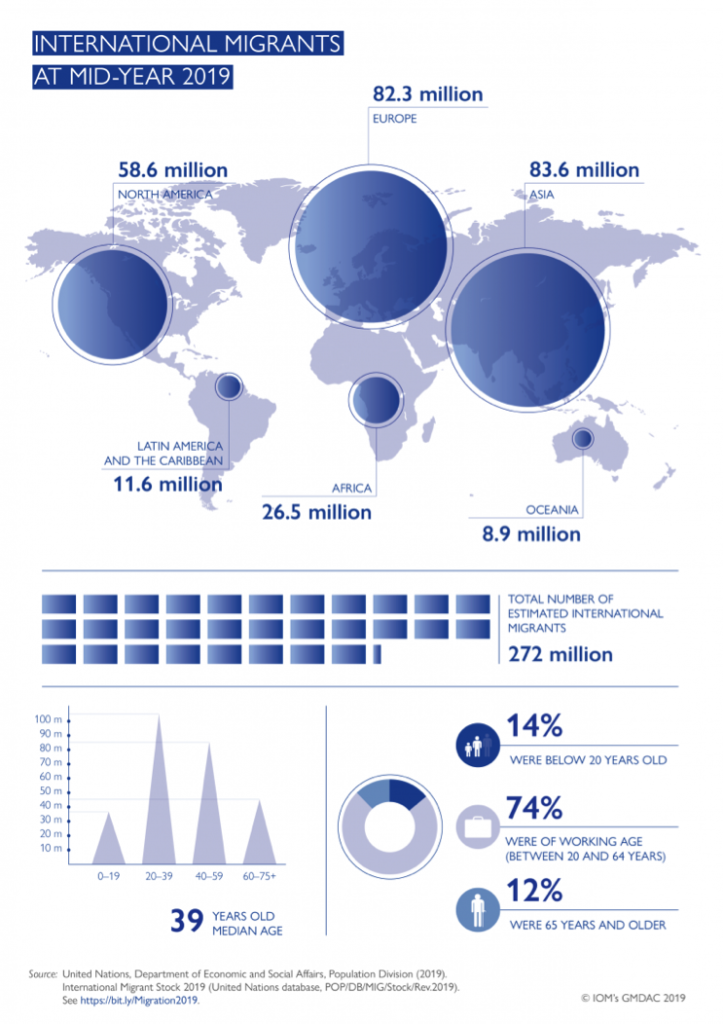
2.2 Solution
- New city: Indonesia’s upcoming capital city, Nusantara, aims to unlock opportunities for professionals, attract foreign investment, facilitate international trade, foster new industries, explore fresh markets, develop infrastructure, and enhance community facilities.
- Migration: The strategic influx of migrants is poised to generate employment, elevate living standards, spur economic growth, enrich cultural diversity, and provide avenues for education and training.
- Borneo: Positioned as a haven for those seeking a rejuvenated life with stability, educational prospects, employment opportunities, and an unpolluted natural environment.
2.3 Mission
- Entity: Form strategic alliances with local government agencies and international migration groups to establish a robust public-private partnership (PPP) investment.
- Goal: Target an annual influx of 600,000 new migrants for the eight designated cities in Borneo, aiming for a total of 18 million migrants by 2050.
Country City 2020 Population 2050 Population (million) Indonesia Samarinda 843K 3.3 Banjarmasin 732K 2.9 Balikpapan 682K 2.7 Pontianak 668K 2.7 Tarakan 193K 1.0 Nusantara 1.5 M (2030) 6.0 Malaysia Kuching 612K 2.5 Kota Kinabalu 550K 2.5 Brunei Bandar Sri Begawan 300K 1.2 Total 6.108 million 24.8 million
3.0 Product
3.1 Product Description
- Migration: Defined as the movement of people from one place to another in pursuit of employment, better opportunities, and improved living standards.
- Offer: Caters to a diverse range of migrants, including international investors, professionals exploring new business opportunities, labourers seeking employment, rural populations migrating to urban centres, and regional expatriate workers with new assignments.
- PPP: A collaboration between public and private enterprises to design and implement a comprehensive migration vision, policies, and programs.
3.2 Product Attributes
- Form: Migrants may be individuals, families, or large groups.
- Demand: New migrants and their families will require various services, including employment, housing, transportation, office spaces, factories, food, healthcare, education, social interaction, infrastructure, and government facilities.
- Positive: Migrants bring positive attributes such as foreign investment, professional specialization, management competency, skilled labour, and economic growth to host countries.
- Partner: The PPP entity plays a crucial role with robust government support and adherence to best international migration practices.
Root causes of migration
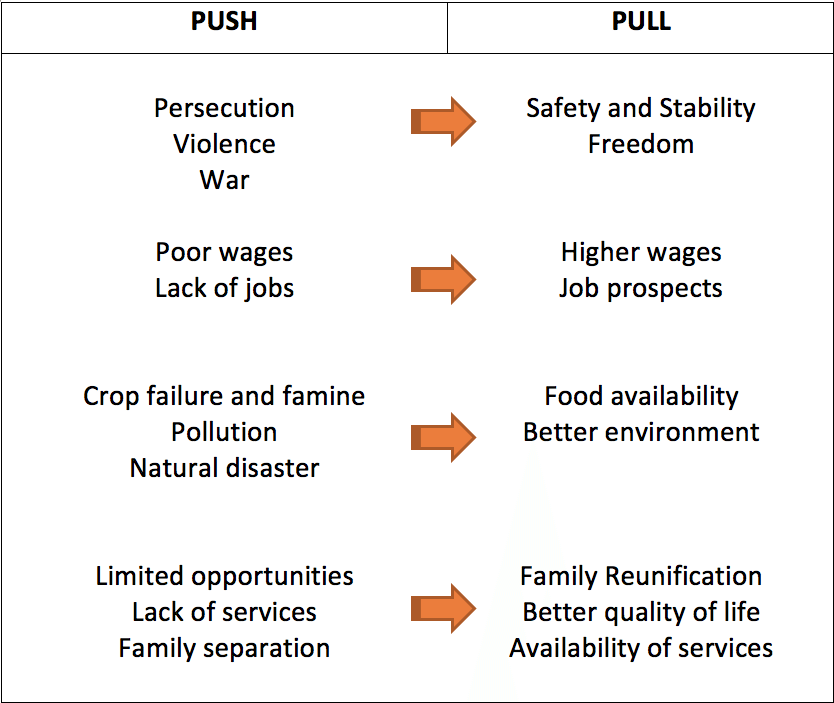
3.3 Product Benefits
- Benefits: Migrants contribute to new social and economic activities.
- Skills: Migrants enhance the productivity of the local labour force by introducing new technology and management skills.
- Invest: Increased investment in education, health, and supporting infrastructure facilities due to migrants.
- PPP: The strategic partnership offers a comprehensive strategy for successfully implementing migration objectives.
3.4 Product Competitive Advantages
- Resource: Borneo boasts vast natural resources, and the land is underpopulated.
- Location: Centrally positioned in the Asia Pacific markets, Borneo attracts North Asia tourists with its proximity, lower costs, pristine beaches, and natural rainforest.
- Growth: Migration serves as a crucial driver of economic activities, drawing parallels from China’s growth over the last 30 years, showcasing the transformative impact of business investment and internal and international migration. China’s urbanization increased from 17% in 1978 to 60% in 2020.
Internal migrant: Rural to Urban China 1995–2000
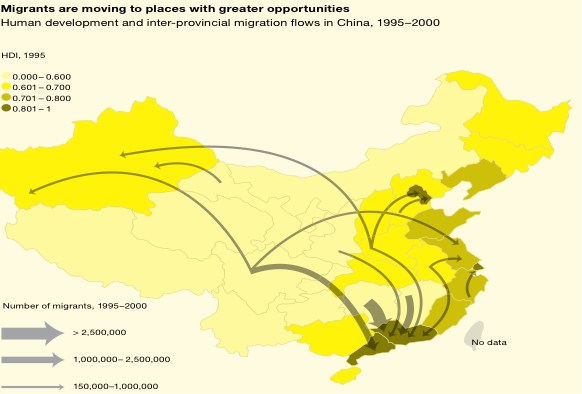
4.0 Market
4.1 Market segment
- Internal migration
Indonesia:
- West Java (43 million)
- East Java (37 million)
- Central Java (32 million)
- North Sumatra (12 million)
- Banten (10 million)
- Jakarta (10 million)
- Rural population: Kalimantan (10 million)
Malaysia:
- 518,000 migrants in 2018: Internal 462,930 / International 55,070
Malaysia migration statistic 2018
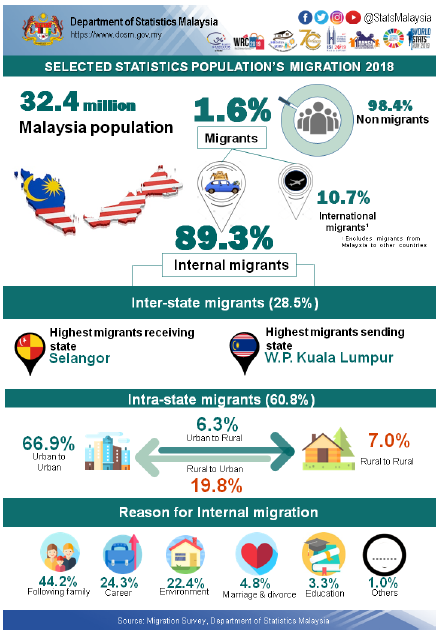
- International migration target markets – Asian cities
Asia:
- China Beijing (21 million)
- Shanghai (27 million)
- Chongqing (15 million)
- Guangzhou (13 million)
- Tokyo (10 million)
- Seoul (10 million)
- Bombay (20 million)
- Hong Kong (7.4 million)
- International migrants target markets – Western countries with historical ties to Borneo:
Target:
- UK (67 million)
- USA (331 million)
- Netherlands (17 million)
- Australia (24 million)
4.2 Target Market Strategy
- Focus:
- Employment and career opportunities
- Family reunion
- Business investments
- Industries:
- Agriculture
- Aviation
- Construction
- Education
- Financial
- Fishery
- Healthcare
- Highway
- Mining
- Property
- Rail
- Seaports
- SEZ
- Specialty chemicals
- Tourism
- Transportation
- Utility industries
- Expats:
- Target 1% of planned migrants, approximately 6,000 foreign expatriate workers per year.
- Internal:
- Target internal migration from Indonesia, Malaysia, and Brunei at around 594,000 per year.
4.3 Market Needs
- Expats:
- In 2017, there were approximately 56.8 million expatriates worldwide.
- 2019 Hong Kong: 385,000 expats
- 2019 Singapore: 1.68 million
- 2019 Malaysia: 3.43 million
- 2021 China: 1.43 million
- 2018 Indonesia: 95,000
- Industries:
- New industries and business investments will necessitate 18 million migrants by 2050.
Top Origin Countries of Immigrants in Indonesia
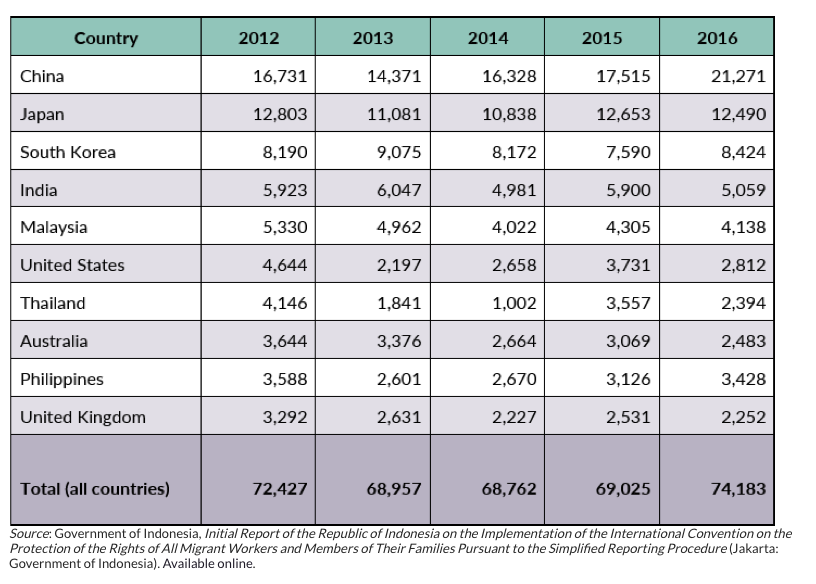
4.4 Growth Drivers
- Drivers:
- Political, demographic, socio-economic, and environmental factors fuel migration to Borneo, offering abundant job opportunities, a pristine environment, political freedom, and a peaceful lifestyle.
- Policy:
- Government policies supporting migrants significantly impact destination choices.
- Location:
- Borneo’s strategic proximity to Asia enhances its appeal as a migration destination.
- Jobs:
- New employment opportunities make Borneo a key attraction for migration.
- New city:
- Indonesia’s new capital is expected to draw 1.5 million public servants, contributing to the region’s growth and appeal.
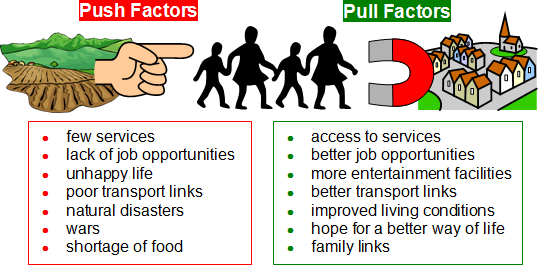
http://geography.parkfieldprimary.com/the-united-kingdom/population-and-migration
4.5 Key Customers
International:
- China
- India
- Malaysia
- Indonesia
- Other ASEAN nations
- Hong Kong
- Korea
- Japan
- Australia
- USA
- UK
- Germany
- Netherlands
- France
- Other Commonwealth nations
Internal:
- Malaysia
- Brunei
- Indonesia
These countries will contribute significantly to the regional migration, supplying both skilled and unskilled labour. The ASEAN nations collectively form a diverse workforce pool.
Case study 1:Foreign workers in Malaysia 2015
Number of foreign workers registered under the PLKS by sector and nationality, as of June 2015.

Case study 2: China
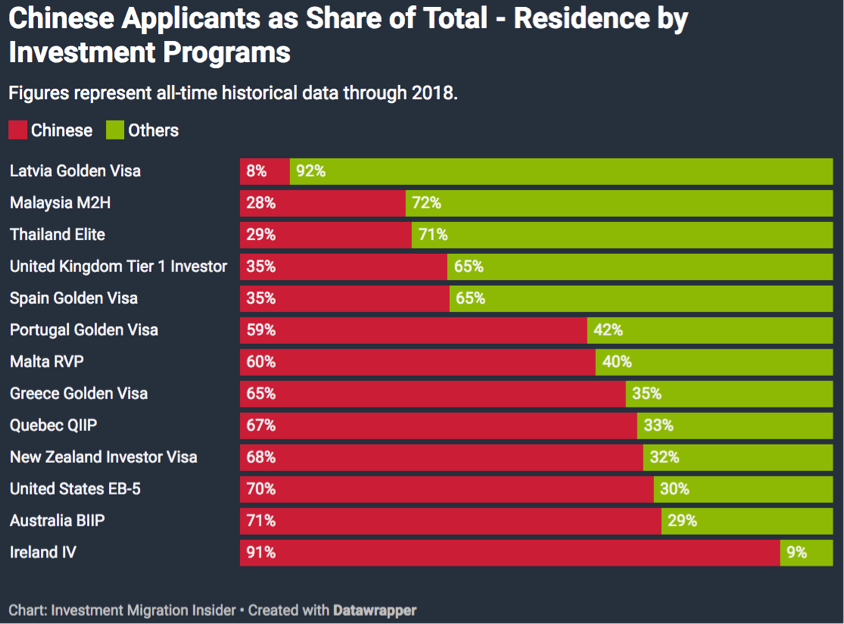
4.6 Competition and Industry
Key Players:
Top Global Immigration Companies:
- ANZ Migrate
- Arton Capital
- Astons
- Bether Capital
- CanAm Enterprises
- Civitas Capital Group
- CMB Regional Centers
- CSB Group
- CS Global Partners
- Global Residency & Citizenship Group
- Golden Gate Global
- Golden Visa Consultancy
- Grupo Siespaña
- Henley & Partners
- Huriya Private
- KPMG
- La Vida
- Latitude Consultancy
- LCR Capital Partners
- Migronis Citizenship
- Planejamento USA
- Primex Immigration
- Silver Fern Immigration
- Vertex Alliance
- Visa Solutions
Top China Investment Migration Companies:
- Austra
- Delsk
- EK Immigration
- Global Visa
- Henry Group
- IANVisa
- QiaoWai
- Visa Consulting
- Wailian
- WellTrend
- WorldWay
Top Immigration Law Firms:
- Ajuria Lawyers
- Bates Wells
- Berry Appleman & Leiden
- Ernst & Young Global (Fragomen, Del Rey, Bernsen & Loewy)
- Greenberg Taurig
- Laura Devine Immigration
- Mayer Brown
- Morgan, Lewis & Bockius
5.0 Operation
5.1 An over-ambitious migration project

5.2 A well-planned migration project

5.3 Malaysia employment pass process
5.4 Indonesia migration process

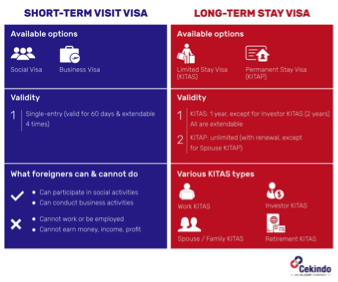
Source: Airswift. Nic Taylor 2020
Source: Cekindo 2022
5.5 Brunei Foreign Workers License process
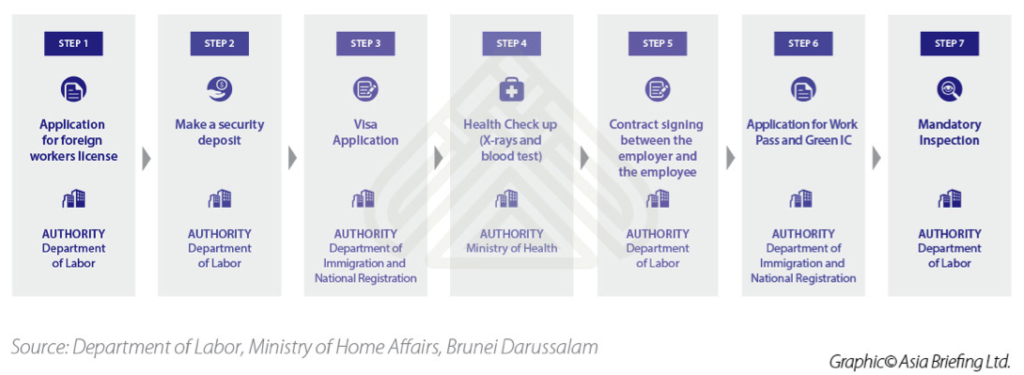
6.0 Financial Implications
6.1 Investment Segment
- International:
- Migrants include foreign expatriates, investors, business entrepreneurs, professionals, and international specialists, all financially independent.
- Internal:
- Domestic and regional workers, contributing to the skilled and semi-skilled labor force, will require additional support from the government in social, health, and education programs.
- Assistance:
- Local, regional, and national governments will provide financial aid and allocate fiscal budgets to meet the needs of new migrants. Additionally, foreign governments will need to establish consulates to cater to their citizens.
Investment by Government
- Investment cost: US$11,000/resident
- Projected migrants: 18 million
- Total investment: US$198 billion
Case study 1: Indonesia’s new capital investment budget
- Preliminary budget: US$33 billion
- Initial population: 3 million (6 million in 2050)
- Investment: US$11,000/resident
Case study 2: Costs to Australia Government
- Based on humanitarian migrants, the cost of settlement services is:
- Settlement service: US$8,000
- Adult English program: US$10,000
- Other costs by the government will cover education, healthcare, utilities, infrastructures, government services, social and community facilities.
6.2 Cost of Migration
Case study 1: Malaysia migration cost 2015
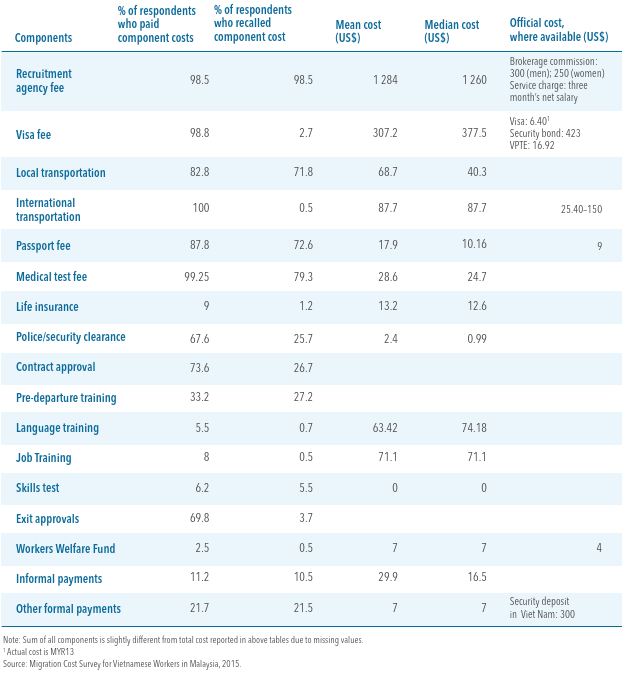
Case study 2: Malaysia annual levy on foreign workers

Case 3: The intending migrant’s total budget:
- Visa application fees
- Costs relating to the application
- Airfares
- Shipping cost
- Initial living expenses in the first year
Cost of living:
- Brunei: US$2,320–US$4,600/month
- Indonesia: US$720–US$2,600/month
- Malaysia: US$940–US$2,100/Month
6.4 Financial Returns
GDP projection: 18 million X US$20,000 (2050) = US$360 billion/year
Case study 1: Australia
A 2016 model study estimated the lifetime fiscal impact of the migration intake of the price-based proposal, generating net fiscal benefits of US$14–18 billion per year.
Case study 2: Australia
By 2050, Australia’s population will be 38 million, and migration is projected to contribute US$1,182 billion to Australia’s GDP. Migration will increase the workforce participation rate by 15% and contribute 6% to GDP per capita growth.
6.5 Source of Funding
1. Strategic investors:
- New investor: Government, PPP, and private sectors.
- Financier: Sovereign funds, private equity, and institutional funds.
- Industries: Target industries including agriculture, aviation, construction, education, financial, fishery, healthcare, highway, mining, property, rail, seaports, SEZ, specialty chemicals, tourism, transportation, and utility segments.
- Target market: Internal, regional, and international migration groups.
2. Private Equities and Investors:
- Private equity fund
- Venture capitals
- Institutional funds
- Sovereign funds
- Private investors in the migration industry
3. Consultants, government agencies and organisations to migration industry
- Indonesia:
- Directorate General of Immigration (Direktorat Jenderal Imigrasi)
- Ministry of Manpower (Kementerian Ketenagakerjaan)
- Malaysia:
- Immigration Department of Malaysia (Jabatan Imigresen Malaysia)
- Ministry of Human Resources (Kementerian Sumber Manusia)
- Brunei:
- Ministry of Home Affairs (Kementerian Hal Ehwal Dalam Negeri)
- Immigration and National Registration Department (Jabatan Imigresen dan Pendaftaran Kebangsaan)
- Labour Department (Jabatan Buruh)
- Consultants:
- BCG
- Ernst and Young
- Expat
- InterNations
- International Organization for Migration (IOM)
- Investment Migration Insider
- KPMG
- McKinsey & Company
- PWC
- Uglobal
- UN
6.6 The Way Forward
- Entity:
- Establish a PPP entity
- Services:
- One-stop service to facilitate government, investors, employers, and employees’ migration needs in the host and target nations.
- Service Includes:
- Migration
- Visa
- Real estate
- Business investment
- Legal framework
- Wealth management
- Banking
- Health care
- Education
- Employment
- Transport
- Social and community support
- Fee:
- Management fee on the comprehensive services.
7.0 Management Team
7.1 Key Management Team
- Mentors: Visionary pioneers and industry leaders with a global network, offering invaluable guidance and inspiration.
- Coaches: Mission-oriented industry experts providing practical solutions to keep the team focused on its objectives.
- Partners:
- Project leadership group experienced in development, operation, and management of migration policies, programs, and projects.
- Government immigration, labour departments, and agencies.
- International migration companies with a successful track record.
- Local and regional migration companies with procurement capabilities, local networks, and solid government support.
- Community support groups in target markets.
In the migration industry, several global leaders have made significant contributions, shaping its growth and success. Here is a list of some of these remarkable individuals, honoured for their vision and dedication:
- Lillian Ajuria
- Desmond Ang
- Armand Arton
- Ali Jahangiri
- Dr. Christian Kälin
- Nuri Katz
- Christian Nesheim
7.2 Key Management Team Model
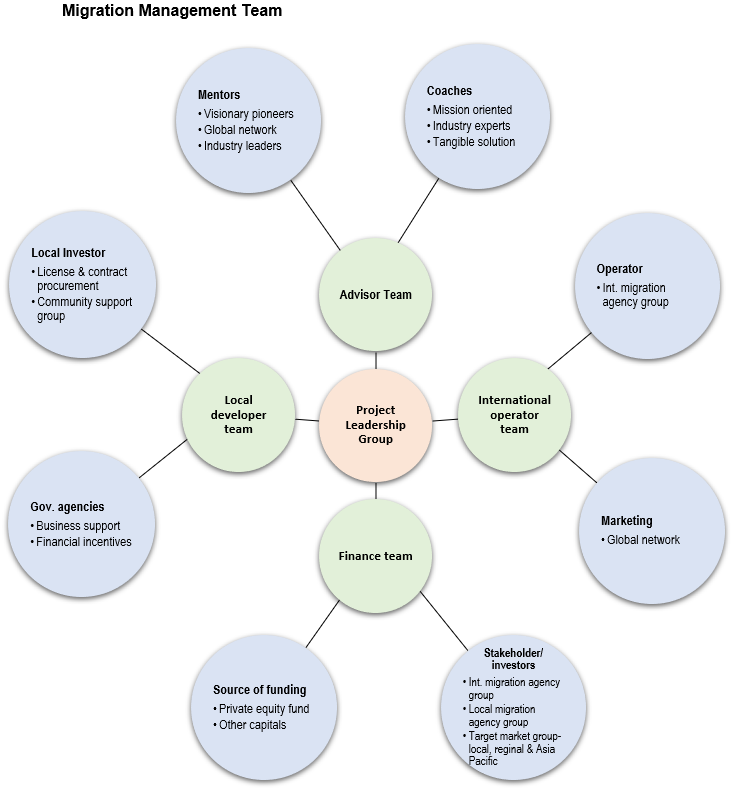
8.0 Unique Business Model
8.1 Successful Track Record
- Team: Teams with successful track records attract the right migrants.
- Policy: Supportive government policies streamline processing for international investors and entrepreneurs.
8.2 Entry Model
- PPP: Public-private partnership (PPP) investment.
8.3 Unique Business Model
- Team: High-caliber partners ensure success.
- Cost: Streamlined approvals lead to lower migration process costs.
- Quality: Legal compliance assurance for employers.
- Support: Proper support for new migrants upon arrival.
- ESG: Policies emphasize transparency, governance, and legality.
9.0 Key Success Factors & Risk Mitigation
9.1 Key Success Factors
- Competency: Use of a merit point system for high-skilled migrant selection.
- Match: Job match for specific industries with credentials, qualifications, and financial incentives.
- Life-style: Attractive lifestyle factors, including natural environment, diverse culture, and community support.
9.2 Risk
- OHS&E: Address health and safety concerns with pre-checks and quarantine.
- Issues: Transparency in recruitment mitigates exploitation and discrimination.
- Culture: Address challenges in adaptation and community blending.
- Security: Manage security risks from migrants with extreme political views.
- Harmony: Avoid adverse reactions from locals through effective communication.
10.0 Exit Strategy
10.1 Exit Form
- Strategic alliances form a single entity with exit strategies like IPO, buy-out, or M & A.